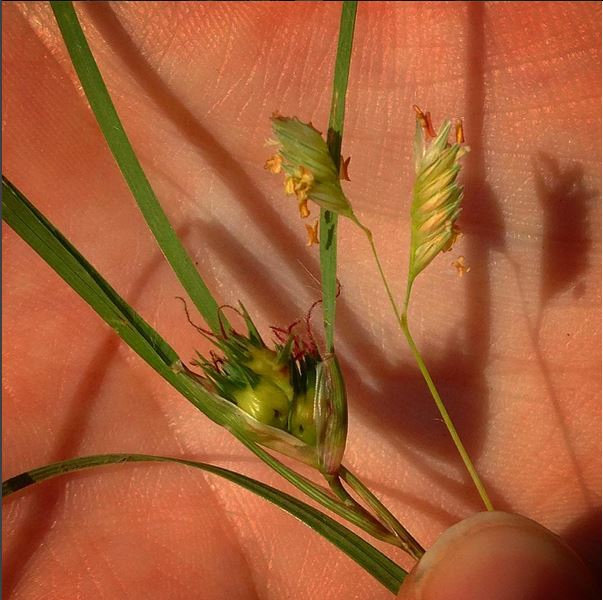Grass identification is a bit challenging for me. However, there is one species I can always pick out of a crowd and for that, it holds a special place in my heart. My predilections aside, it is a fascinating species with an ecology worth getting to know a bit better. Today I would like to introduce you to the indomitable buffalo grass.
Known scientifically as Bouteloua dactyloides, this is one of the few dioecious grass species you can readily encounter here in North America. It is a denizen of the great planes and once thrived in the wake of disturbance left by massive herds of bison. Today you are more likely to encounter it growing alongside trails and other areas where taller vegetation is kept at bay. It is a hardy species and does exceptionally well in drought-prone soils. Like all warm season grasses, its photosynthetic machinery employs the C4 pathway, allowing buffalo grass to conserve moisture while ramping up photosynthesis during the hottest months of summer.
Colonies of buffalo grass are stoloniferous, sending out creeping horizontal stems that will grow into new plants over time. Its small stature makes it easy to overlook. Flowering changes that. As mentioned above, buffalo grass is dioecious, which is kind of an odd trait for a grass. For the most part, male and female flowers exist on separate plants. Because pollen is wind dispersed, male flowers reach far above the leaves, ready to take advantage of the slightest breeze. Female plants present their flowers much closer to the ground, perhaps as a way of avoiding herbivory. Research has shown that, in any given population, monoecious plants are produced from time to time. It is thought that this might give buffalo grass a leg up when it comes to colonizing new habitats. If buffalo grass was strictly dioecious, both male and female seeds would have to find their way into a new habitat at the same time in order for a new population to establish. However, by producing monoecious seeds on occasion, the chances of being able to successfully reproduce in a new habitat increases.
Why this species has evolved to be dioecious is a bit of a mystery. Research on other dioecious plants suggest that it is a way of dealing with various environmental stresses such as competition and herbivory. Work on buffalo grass shows no significant bias towards males or females in any region. Most populations studied exhibit a 1:1 male to female ratio. Some plants seem to be able to switch over their lifetime, especially as it relates to new plants produced on stolons. Regardless of the selective pressures, buffalo grass seems to be doing quite well. Due to its small size and hardy disposition, many are looking towards buffalo grass as a great native lawn alternative. It doesn't require mowing and hot summer days don't seem to bug it. Couple that with its turf-like growth habit and you have yourself an excellent alternative to grasses like Kentucky bluegrass (Poa pratensis), which requires endless amount of water, fertilizer, and mowing to keep it up to our (dare I say) absurd standards.

